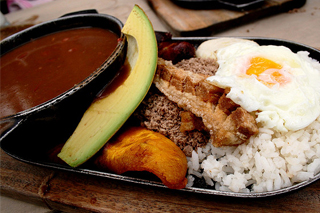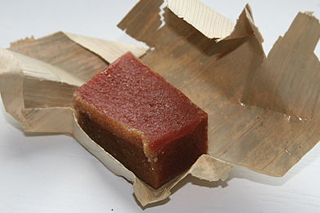Despite extensive journeys around Latin America and an incurable curiosity about all things foodie, I was still a complete novice in terms of Colombian cuisine when invited to sample the culinary delights at the Otro Sabor festival in Medellín – the start of a new food love affair and an increased interest in Colombia as a tourist destination.
Medellín, Colombia’s second city, is known as “the city of eternal spring” because of its pleasant year-round climate and on my first morning it was kindly living up to its name as I headed for the botanical garden in gentle sunshine. This garden, founded in 1972 and known in particular for its orchids, is well worth a visit any time of year, but on this occasion it was playing host to Colombia’s main gastronomy event, the Otro Sabor food festival, running annually the last weekend of August.
For three whole days this culinary extravaganza takes over the garden, each year with a different theme and on occasion other Latin American countries are invited to participate. As an introduction to Colombian cuisine I couldn’t have asked for a better range of dishes, or a prettier location. In the main buildings inside the garden talks and cookery displays were held, whereas the large, covered outdoor area was teeming with stands from all over Colombia and neighbouring countries. Chefs were cooking up a storm and all dishes could be sampled for a small fee. There was nothing for it but to tuck in.
Most ubiquitous in all of Colombia is probably the arepa, a flat corn bread, which can be enjoyed hot on its own, with all manner of exciting fillings or as part of a main meal. I tried mine with cheese as a starter, before homing in on the ultimate “hog-fest”, literally and metaphorically; la bandeja paisa, or paisa try, from the region of Antioquia, of which Medellín is the capital. This takes some beating in the calorie stakes, I reckon, but it’s a gorgeously filling and tasty meal if you’re of a carnivorous bent. My plate piled high with pork sausage, ground pork, pork cutlets and crackling, morcilla (a type of blood sausage), fried plantain, rice, brown beans, avocado and salad all topped off with a fried egg, I found a seat in a shady patio perfect for quiet munching. I had a feeling me and Colombian food would get on just fine.

Bandeja Paisa
Photo by: Nicole Tarazona
As it turned out, I wasn’t wrong and over the next couple of days I enjoyed the dizzying array and astounding variety of Colombian cuisine, including fresh fruits and vegetables every colour of the rainbow, many of which I had never encountered before and have yet to find English translations for. Although meat is incredibly popular, with pork reigning supreme, at least in the centre of the country, and they have beef to rival Argentina, fish is also in plentiful supply, with trout particularly popular inland, whereas seafood dishes abound on both coasts and is especially delicious on the Caribbean. Sated, but not stuffed silly, I continued my journey to Bogotá, the capital. At first it seemed I had moved from eternal spring straight into autumn, skipping summer altogether. Bogotá, at 2,640 metres, is the third-highest capital in the world and has a somewhat cooler, but still pleasant, climate. To shop as the Colombians do, I headed for the Paloquemao market –the place for all your fruit, vegetables and flower needs, as well as meat, fish, seafood and dairy products. The earlier you visit the better and the stallholders are often keen for you to try their goods. This is where I became acquainted with the goldenberry, the yellow dragonfruit and the giant soursop, or guanabana, as well as bright purple potato look-alikes and other tubers.
After such a start to the day, the colourful displays of a Colombian market would be a hard act to follow. Or so I thought… An afternoon spent at one of Bogotá’s best restaurants – Leo Cocina y Cava – did the trick. The menu included the very best and most exotic that national cuisine has to offer, from carpaccio of conch to tuna in panela with fat-bottomed ants from Santander in the north. To suddenly become an “anteater” was a definite first and despite the initial squeamishness factor, I was pleasantly surprised by the crunchy, nutty texture. All was washed down with a corozo martini, made from a palm tree fruit.

Bocadillo
Photo by: Trotskij
Despite all this wonderful food, there was clearly something missing in my adventures, something everyone knows to truly be a taste of Colombia: coffee. To find out all about the black gold of the nation I based myself in the small town of Salento in the province of Quindío, the heart of the coffee region, or La Zona Cafetera. Teaming up with Jesús Bedoya, who runs a café in Salento, Café Jesús Martín Bedoya, I set out to explore all things coffee during my stay. Jesús, whose father still has an old coffee finca, is passionate about these humble beans and their much-loved liquid, and he knows his stuff.
After visiting his small coffee roasting factory and getting the grand tour, we also stopped by his father’s finca, Finca Santana, and the coffee plantation nearby. By now the process of growing, picking, drying and roasting the coffee beans was beginning to sink in – an enormous amount of work goes into that mug, cappuccino or tiny espresso that so many of us enjoy every day and I found myself feeling awestruck. Jesús also gives talks in schools, teaching young Colombians about the intricacies of coffee and accompanying him to the local university in Armenia, the largest town in Quindío to listen to his lecture, I had long, albeit very interesting day. There was only one way to round it off – with Colombian rum…
By Anna Maria Espsäter
First UK Rights























